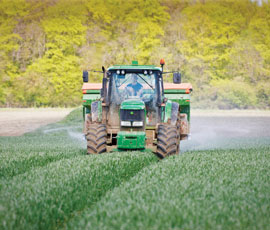Trials will fine tune nitrogen needs for wheat

A new on-farm project is set to kick off this spring aimed at giving better advice on nitrogen fertiliser rates needed for growing winter wheat.
Some 18-plus wheat growers are being sought to take part in these trials which hope to push up potential wheat yields while reducing leaching losses.
Researchers believe some farms may need more nitrogen then currently recommended to achieve higher wheat yields while others may need less.
The four-year LearN project – majority-funded by the HGCA with support from distributor Agrii and fertiliser group GrowHow – is being aimed at giving growers advice to get their nitrogen rates spot on.
The £350,000 research work, to take place over 2014-2017, is to be conducted by crop scientists ADAS and consultants NIAB TAG, with wheat growers providing the on-farm trial sites.
“We are looking to better predict nitrogen application rates, as nitrogen may have some impact on the yield plateau,” says Roger Sylvester-Bradley, head of crop performance at ADAS.
Average nitrogen rates have been stable at about 190kg/ha for the past 30 years and as grain protein is slowly declining there is evidence that growers are under-fertilising, while wheat yields have stagnated over the past 20 years, he adds.
The wheat world record holder Mike Solari harvested a crop of 15.7t/ha in 2010 in New Zealand using 450kg/ha of nitrogen with an extra 85kg/ha coming from a preceeding pea crop.
“Higher yields will need extra nitrogen. The current guidance is improving but the current advice is very imprecise,” he says.
Daniel Kindred, senior research scientist at ADAS, says some growers may need consistently more or less fertiliser as advised by DEFRA’s Fertiliser Manual (RB209).
These guidelines suggest growers on medium soils and average soil nitrogen contents should use 220kg/ha on their wheat crops.
“Our aim is to enable individual farmers to determine whether, on average, their nitrogen use on wheat is about right, too much or too little,” he says.
The researchers are looking for six “core” farm sites in eastern England to conduct plot trials and 12-plus farm extension sites across Britain which will use tramline trials.
This latter group would use three different treatments along different tramlines, one using the farm’s standard nitrogen rate and one 50kg/ha more and another 50kg/ha less.
He says that if the extra 50kg/ha gives a yield response of more than 0.3t/ha, then the standard level of nitrogen is likely to be too low.
Stuart Knight, director of crops and agronomy at NIAB TAG, says the extra 50kg/ha would be applied at the main nitrogen application in early April and its effect could be measured by yield mapping from the combine.
Wheat growers interested in taking part should contact Daniel.Kindred@adas.co.uk as soon as possible. The final selection will be made by 31 January.

